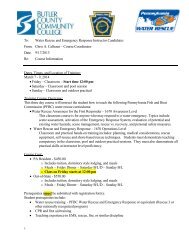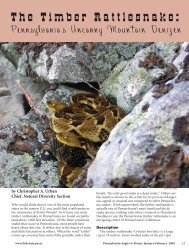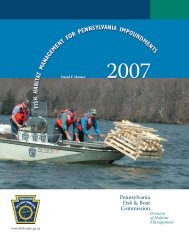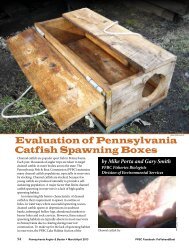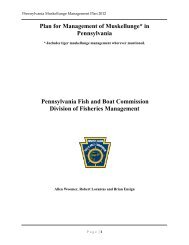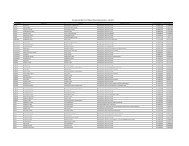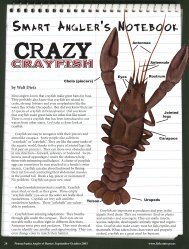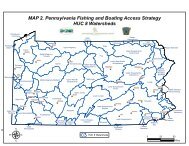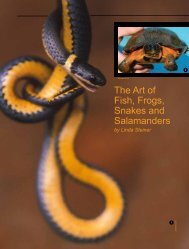TEN CENTS - Pennsylvania Fish and Boat Commission
TEN CENTS - Pennsylvania Fish and Boat Commission
TEN CENTS - Pennsylvania Fish and Boat Commission
You also want an ePaper? Increase the reach of your titles
YUMPU automatically turns print PDFs into web optimized ePapers that Google loves.
18 PENNSYLVANIA ANGLER FEBRUARY<br />
of swift water—that is, near the left side<br />
facing upstream. Different tactics must be<br />
employed here.<br />
If the angler is left h<strong>and</strong>ed, the same procedure<br />
can be followed as that illustrated in<br />
Fig. 2. If not, he must place himself in the<br />
position of a left h<strong>and</strong>ed caster—that is, the<br />
casting will be done with the right arm only<br />
crossed over the left—all being done as before<br />
in a horizontal plane parrallel to the<br />
water.<br />
The two methods outlined above can be<br />
applied practically to any conditions, provided<br />
there is sufficient space in the rear to<br />
allow clearance for the back cast. Unfortunately<br />
such clearance—-due to brush <strong>and</strong><br />
trees—is not always available <strong>and</strong> the overhead<br />
or snake cast may be resorted to.<br />
Refer to Fig. 4. This cast is accomplished<br />
by retarding shooting of the line. A number<br />
of coils are held in the left h<strong>and</strong> <strong>and</strong> the<br />
usual preliminary false casts are made overhead<br />
in the air. On the final cast when the<br />
critical time is sensed for shooting the line,<br />
delay its action, just a trifle. It will fall on<br />
the water as shown, sinuosities occuring in<br />
the line with the leader usually remaining<br />
straight. As usual the trick is to gauge the<br />
distance so that the sinuosities occur in the<br />
intervening swift water.<br />
There are doubtless other tricks resorted<br />
to by anglers in eliminating drag, but the<br />
ones described above are probably the easiest<br />
to learn. All are more or less baffling <strong>and</strong><br />
fortunate indeed is the angler, who can<br />
consistently place his fly so that drag will<br />
not occur.<br />
BUILDING PROGRAM AT BELLEFONTE<br />
HATCHERY<br />
Extensive building operations are being<br />
carried on at the Pleasant Gap unit of the<br />
<strong>Commission</strong>'s Bellefonte hatchery.<br />
At the lower or northern end of the hatchery,<br />
an area of four acres, bordering on the<br />
state highway, is being developed into one<br />
of the most modern fresh water biological<br />
research stations in the United States. It<br />
will be operated in conjunction with the<br />
biological research laboratory at the Pleas<br />
ant Gap hatchery under the supervision of<br />
C. R. Buller, the commission's chief fish<br />
culturist.<br />
Also under construction is a large building<br />
to be used for cold storage <strong>and</strong> as a plant<br />
for fish food preparation. It will have a<br />
storage capacity of 50 tons of food for use<br />
at the three units of the Bellefonte hatchery.<br />
The amount of food needed for the three<br />
units, Pleasant Gap, Upper <strong>and</strong> Lower Spring<br />
Creek hatcheries, is from 1% to 2 tons per<br />
day in the fall when the fish in the ponds<br />
have grown larger.<br />
When the expansion program has been<br />
completed there will be between 525 <strong>and</strong> 550<br />
ponds <strong>and</strong> pools for growing all kinds of fish<br />
at the three hatcheries. In addition to trout<br />
<strong>and</strong> bass, catfish, sunfish, yellow perch <strong>and</strong><br />
suckers will be raised. The Board of <strong>Fish</strong><br />
<strong>Commission</strong>ers is constructing the storage<br />
plant <strong>and</strong> the W. P. A. is providing labor for<br />
construction of the ponds.<br />
At the research station problems pertaining<br />
to the improvement of fish food in streams<br />
<strong>and</strong> lakes, fish diseases <strong>and</strong> selective breeding<br />
of fish are studied.<br />
SEEK TO RECLASSIFY CARBON<br />
TROUT STREAMS<br />
The Palmerton Rod <strong>and</strong> Gun Club will<br />
make official application to the <strong>Fish</strong> <strong>Commission</strong><br />
for the reclassification of three<br />
streams in Lower Carbon County from brook<br />
trout to brown trout streams.<br />
Secretary Ira J. Bleiler announced that at<br />
a meeting the club had voted to request the<br />
commission to reclassify the Aquashicola,<br />
Buckwa <strong>and</strong> Hunters creeks from brook trout<br />
to brown trout streams. The decision was<br />
based on a detailed study of the three streams<br />
during the past two years <strong>and</strong> general observations<br />
covering the past ten years.<br />
According to reports submitted to the meeting,<br />
none of the three streams under question<br />
had successfully maintained brook trout<br />
other than on a season-to-season basis <strong>and</strong><br />
that both brook <strong>and</strong> rainbow trout which<br />
have been consistently stocked by the club<br />
over a period of ten years had not thrived<br />
in these waters.<br />
Four days after it was opened to the public for fishing, Egypt Meadow dam, 74 acres in area, was one<br />
at the most popular fishing spots in Pike County, reports Warden Frank Brink who sent in this photo.<br />
Ralph Stewart with a fine brace of rainbow trout<br />
taken last year In the <strong>Fish</strong> <strong>Commission</strong>'s Spring<br />
Creek Project near Bellefonte, Centre County. The<br />
largest rainbow was 23 inches in length <strong>and</strong> weighed<br />
4 pounds 8 ounces.<br />
While none of the three streams have evef<br />
been stocked with brown trout there have<br />
been some unusually large brown trou'<br />
caught in all three streams. Secretary Bleilef<br />
stated that the species was probably introduced<br />
to the system several years ago when<br />
the club received a shipment of small trou'<br />
from the Federal government for stocking'<br />
He pointed out that brown trout will spawn<br />
in large streams whereas brook trout invari'<br />
ably seek smaller streams in which to spawn,<br />
thus making the Aquashicola, Buckwa <strong>and</strong><br />
Hunters creeks ideal breeding grounds for<br />
brown trout.<br />
It was through the efforts of the Palmerton<br />
Rod <strong>and</strong> Gun Club several years ago that<br />
Big Creek received a classification under the<br />
brown trout group after the stream gave<br />
positive indications of failing as a good brooK<br />
trout stream.<br />
George Kannapel was appointed chairman<br />
of a special nominating committee to prepare<br />
recommendations for the nomination for the<br />
offices of president, vice president, secretary,<br />
treasurer <strong>and</strong> field captain for the club f




